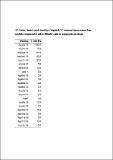Por favor, use este identificador para citar o enlazar a este item:
http://hdl.handle.net/10261/134650COMPARTIR / EXPORTAR:
 SHARE SHARE
 CORE
BASE CORE
BASE
|
|
| Visualizar otros formatos: MARC | Dublin Core | RDF | ORE | MODS | METS | DIDL | DATACITE | |

| Título: | Auto-Adhesion Potential of Extraocular Aqp0 during Teleost Development |
Autor: | Chauvigné, François CSIC ORCID; Fjelldal, Per Gunnar; Cerdà, Joan CSIC ORCID ; Finn, Roderick N. | Fecha de publicación: | may-2016 | Editor: | Public Library of Science | Citación: | PLoS ONE 11(5): e0154592 (2016) | Resumen: | AQP0 water channels are the most abundant proteins expressed in the mammalian lens fiber membranes where they are essential for lens development and transparency. Unlike other aquaporin paralogs, mammalian AQP0 has a low intrinsic water permeability, but can form cell-to-cell junctions between the lens fibers. It is not known whether the adhesive properties of AQP0 is a derived feature found only in mammals, or exists as a conserved ancestral trait in non-mammalian vertebrates. Here we show that a tetraploid teleost, the Atlantic salmon, expresses four Aqp0 paralogs in the developing lens, but also expresses significant levels of aqp0 mRNAs and proteins in the epithelia of the pronephros, presumptive enterocytes, gill filament and epidermis. Quantitative PCR reveals that aqp0 mRNA titres increase by three orders of magnitude between the onset of somitogenesis and pigmentation of the eye. Using in situ hybridization and specific antisera, we show that at least two of the channels (Aqp0a1, -0b1 and/or -0b2) are localized in the extraocular basolateral and apical membranes, while Aqp0a2 is lens-specific. Heterologous expression of the Aqp0 paralogs in adhesion-deficient mouse fibolast L-cells reveals that, as for human AQP0, each intact salmon channel retains cell-to-cell adhesive properties. The strongest Aqp0 interactions are auto-adhesion, suggesting that homo-octamers likely form the intercellular junctions of the developing lens and epithelial tissues. The present data are thus the first to show the adhesion potential of Aqp0 channels in a non-mammalian vertebrate, and further uncover a novel extraocular role of the channels during vertebrate development | Descripción: | 21 pages, 6 figures, supporting information https://dx.doi.org/10.1371/journal.pone.0154592 | Versión del editor: | https://dx.doi.org/10.1371/journal.pone.0154592 | URI: | http://hdl.handle.net/10261/134650 | DOI: | 10.1371/journal.pone.0154592 | Identificadores: | doi: 10.1371/journal.pone.0154592 issn: 1932-6203 e-issn: 1932-6203 |
| Aparece en las colecciones: | (ICM) Artículos |
Ficheros en este ítem:
| Fichero | Descripción | Tamaño | Formato | |
|---|---|---|---|---|
| Chauvigne_et_al_2016.PDF | 27,91 MB | Adobe PDF |  Visualizar/Abrir | |
| Chauvigne_et_al_2016_s_1.PDF | 70,03 kB | Adobe PDF |  Visualizar/Abrir | |
| Chauvigne_et_al_2016_s_2.PDF | 21,01 kB | Adobe PDF |  Visualizar/Abrir |
CORE Recommender
PubMed Central
Citations
3
checked on 06-abr-2024
SCOPUSTM
Citations
5
checked on 19-abr-2024
WEB OF SCIENCETM
Citations
4
checked on 27-feb-2024
Page view(s)
214
checked on 23-abr-2024
Download(s)
316
checked on 23-abr-2024

